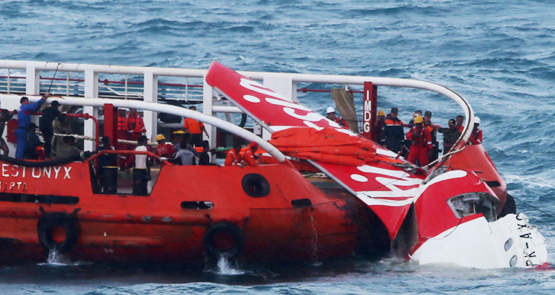Indonesian authorities have suggested or implied several reasons why an AirAsia A320 crashed into the Java Sea last month, including: an abnormal climb rate; possible pre-existing damage to the jet; and questions about training and pilot standards.
The hard facts are that the jet, at one brief stage, was climbing at a rate of 1800 metres per minute soon after the pilots began increasing its cruising altitude from 32,00o feet to 38,000 feet in crowded airspace to avoid bad weather. This, as Indonesia’s Transport Minister Ignasius Jonan said, was “abnormal”. “In the final minutes, the plane climbed at a speed which was beyond normal,” he said, noting this was a rate more typical of fighter jets than airliners.
“The plane suddenly went up at a speed above the normal limit that it was able to climb to. Then it stalled.”
However, an additional factor that has now been raised by the investigators twice in the past day include possible pre-existing mechanical issues or damage with the A320 that was operating the December 28 flight between Surabaya and Singapore.
Those references included comments that unidentified mechanical noises were heard in the cockpit voice recording, which continues to be analysed alongside information found on the flight data recorder for clues as to the sequence of events that destroyed the flight.
Investigator Nurcahyo Utomo was quoted as saying the crash team was looking at possible plane damage and human factors.
The reference to human factors is shorthand for how the pilots were prepared by AirAsia, which is responsible for their competency and actions, for an “upset” or “loss of control” situation.
It touches on an issue that has been of growing concern to Airbus, Boeing, and the major air-safety regulators in recent years because of evidence that some airlines have placed too much faith in automation, or the use of autopilot functions and other control-system “protections”, leaving pilots unprepared for an “upset” or unable to understand what the jet they are flying is doing when something beyond routine happens during a flight.
Without prejudice to AirAsia, this is a very serious and acknowledged problem in the airline industry, and it has been discussed at official levels as a matter that requires urgent review and, where appropriate, regulatory changes.
The Indonesian investigators expect to issue a preliminary report on the accident next week. In the Java Sea, difficulties with lifting equipment in stormy conditions are frustrating efforts to raise the main section of the crashed jet’s cabin from its location at a depth of around 30 metres.
There is uncertainty as to how many of the victims have been recovered pending forensic identification, but until yesterday the number was given as 52 or 53 of the 162 people who were on board flight QZ8501.









Crikey is committed to hosting lively discussions. Help us keep the conversation useful, interesting and welcoming. We aim to publish comments quickly in the interest of promoting robust conversation, but we’re a small team and we deploy filters to protect against legal risk. Occasionally your comment may be held up while we review, but we’re working as fast as we can to keep the conversation rolling.
The Crikey comment section is members-only content. Please subscribe to leave a comment.
The Crikey comment section is members-only content. Please login to leave a comment.